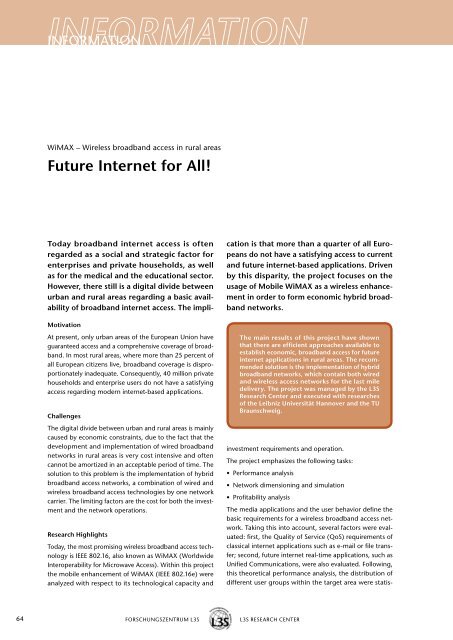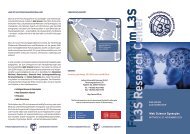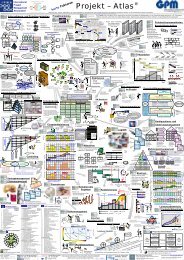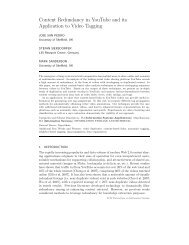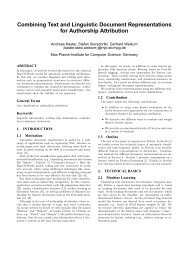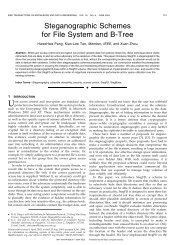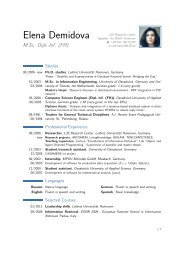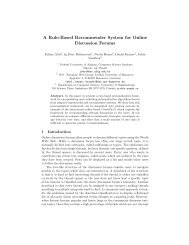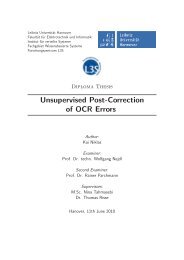knowledge · information · learning - Forschungszentrum L3S
knowledge · information · learning - Forschungszentrum L3S
knowledge · information · learning - Forschungszentrum L3S
You also want an ePaper? Increase the reach of your titles
YUMPU automatically turns print PDFs into web optimized ePapers that Google loves.
64<br />
INFORMATION<br />
WiMAX – Wireless broadband access in rural areas<br />
Future Internet for All!<br />
Today broadband internet access is often<br />
regarded as a social and strategic factor for<br />
enterprises and private households, as well<br />
as for the medical and the educational sector.<br />
However, there still is a digital divide between<br />
urban and rural areas regarding a basic availability<br />
of broadband internet access. The impli-<br />
Motivation<br />
At present, only urban areas of the European Union have<br />
guaranteed access and a comprehensive coverage of broadband.<br />
In most rural areas, where more than 25 percent of<br />
all European citizens live, broadband coverage is disproportionately<br />
inadequate. Consequently, 40 million private<br />
households and enterprise users do not have a satisfying<br />
access regarding modern internet-based applications.<br />
Challenges<br />
The digital divide between urban and rural areas is mainly<br />
caused by economic constraints, due to the fact that the<br />
development and implementation of wired broadband<br />
networks in rural areas is very cost intensive and often<br />
cannot be amortized in an acceptable period of time. The<br />
solution to this problem is the implementation of hybrid<br />
broadband access networks, a combination of wired and<br />
wireless broadband access technologies by one network<br />
carrier. The limiting factors are the cost for both the investment<br />
and the network operations.<br />
Research Highlights<br />
Today, the most promising wireless broadband access technology<br />
is IEEE 802.16, also known as WiMAX (Worldwide<br />
Interoperability for Microwave Access). Within this project<br />
the mobile enhancement of WiMAX (IEEE 802.16e) were<br />
analyzed with respect to its technological capacity and<br />
FORSCHUNGSZENTRUM <strong>L3S</strong> <strong>L3S</strong> RESEARCH CENTER<br />
cation is that more than a quarter of all Europeans<br />
do not have a satisfying access to current<br />
and future internet-based applications. Driven<br />
by this disparity, the project focuses on the<br />
usage of Mobile WiMAX as a wireless enhancement<br />
in order to form economic hybrid broadband<br />
networks.<br />
The main results of this project have shown<br />
that there are efficient approaches available to<br />
establish economic, broadband access for future<br />
internet applications in rural areas. The recommended<br />
solution is the implementation of hybrid<br />
broadband networks, which contain both wired<br />
and wireless access networks for the last mile<br />
delivery. The project was managed by the <strong>L3S</strong><br />
Research Center and executed with researches<br />
of the Leibniz universität Hannover and the Tu<br />
Braunschweig.<br />
investment requirements and operation.<br />
The project emphasizes the following tasks:<br />
• Performance analysis<br />
• Network dimensioning and simulation<br />
• Profitability analysis<br />
The media applications and the user behavior define the<br />
basic requirements for a wireless broadband access network.<br />
Taking this into account, several factors were evaluated:<br />
first, the Quality of Service (QoS) requirements of<br />
classical internet applications such as e-mail or file transfer;<br />
second, future internet real-time applications, such as<br />
Unified Communications, were also evaluated. Following,<br />
this theoretical performance analysis, the distribution of<br />
different user groups within the target area were statis-


